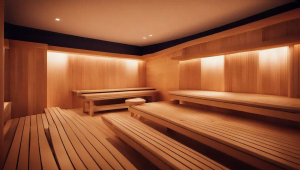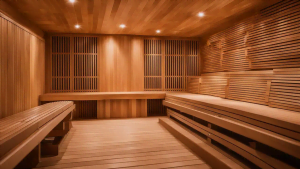Types of infrared saunas: Analyzing your options for thermal therapy
Infrared saunas are a modern take on the traditional steam-based thermal baths, producing radiant heat that infrared heaters absorb straight into your body. Compared to conventional spas that heat the air surrounding you, infrared saunas offer a more pleasant experience by letting you enjoy warmth comparable to the sun’s rays without the risk of UV radiation.
For individuals unable to bear the heat of a traditional sauna, this direct heating approach allows you to experience the health advantages of infrared bathing at lower temperatures. Selecting an infrared outdoor sauna that meets your wellness objectives and lifestyle requires knowledge of the many varieties available.
Spas that use far-infrared light, known for penetrating deep into tissues, can aid post-workout recovery after strength and endurance training. Research indicates that near-infrared saunas may help lower cholesterol levels and reduce waist size. Examining the physiological reactions of fit women to infrared saunas versus exercise might provide helpful details for people looking for fitness benefits similar to minor exercise.
What is an infrared sauna?
An infrared sauna with heaters is intended to enhance overall health and well-being, lessen stress, promote sound sleep, and provide a variety of other advantages. It is located inside a wooden cabin. Infrared baths offer comparable benefits to traditional steam rooms without subjecting users to excessively high temperatures.
Scientific research has confirmed that infrared baths offer several health benefits, including reduced stress, pain relief from muscles and joints, enhanced circulation, and skin pore cleansing. In the wellness business, infrared baths are gaining popularity due to their numerous health benefits and potential to raise happiness.
Types of infrared saunas
 In the example below, there are many kinds of infrared saunas:
In the example below, there are many kinds of infrared saunas:
- Far-Red Saunas: Infrared saunas that emit light with longer wavelengths—typically between 5.6 and 15 micrometers—are known as far-infrared saunas. Far-infrared bathrooms are well known for their capacity to provide deep, interior body heating. They are more pleasant for longer sessions since they run at a lower temperature than traditional spas.
- Full-Spectrum Infrared Spas: These cabins combine near-, mid-, and far-infrared light frequencies. Every wavelength has a unique way of reaching the body and providing therapeutic advantages. Full-spectrum baths use a variety of wavelengths to offer a greater range of health advantages.
- Near and Mid-Infrared Saunas: Whereas mid-infrared spas generate light at frequencies between 1.5 and 5.6 micrometers, near-infrared spas emit light at frequencies between 0.75 and 1.5 micrometers. Although mid-infrared light may enter the body more deeply to enhance relaxation and circulation, near-infrared light is widely recognized for its capacity to revitalize skin and heal injuries.
There are three types of infrared saunas: far-infrared, full-spectrum (which combines far, halfway, and near-infrared), and near/mid-infrared. Every sort of spa targets different body depths for health benefits and offers a variety of benefits.
See more: Which Sauna Blanket Is Best for Tall People? (Six Feet or More)
The Infrared Sauna’s Scientific Basis
Understanding infrared spas and their advantages is essential before exploring the many kinds of these devices. Using infrared light, infrared saunas heat the body’s tissues directly without burning the surrounding air. Because this heating technology works at lower temperatures than traditional steam rooms, it is simpler for many people to sweat and detoxify their bodies.
The main way that infrared spas differ from conventional spas is in how they produce heat. In contrast to infrared bathrooms, which produce infrared light to heat the body directly, traditional spas use warm air or steam. Deeper tissue entry, higher perspiration efficiency, and a reduced felt temperature are just a few benefits of this direct heating method.
Comparison with Other Types of Saunas
 It’s important to consider variations in the thermal source, humidity level, and geographic footprint of each type of spa while comparing various options. This knowledge will help you choose the thermal experience that most closely matches your needs and tastes. The following is a comparison between infrared saunas and other sauna types:
It’s important to consider variations in the thermal source, humidity level, and geographic footprint of each type of spa while comparing various options. This knowledge will help you choose the thermal experience that most closely matches your needs and tastes. The following is a comparison between infrared saunas and other sauna types:
Conventional Saunas:
- Heat Source: Conventional saunas use a fire or heater to heat rocks to ensure heat is distributed throughout the room.
- Temperature: Perform at higher temperatures, usually in the range of 70°C to 100°C (158°F to 212°F).
- Humidity: In general, traditional baths are less humid than infrared saunas.
- Experience: Users feel a lot of heat, which might make them sweat and relax.
Steam rooms:
- Heat Source: Steam generators are used in steam baths to produce steam, which produces heat.
- Temperature: Usually, operators operate between 40°C and 50°C (104°F and 122°F), which is lower than in regular spas.
- Humidity: Because steam is present, steam spas have high humidity levels.
- Experience: Users complain of moist heat, which might cause sweat to open pores and aid in detoxifying.
Electric Saunas:
- Heat Source: Electric heaters are used to produce heat in electric spas.
- Temperature: Electric spas function at greater temperatures than conventional spas do.
- Humidity: The design and ventilation of the bathhouse may affect the humidity levels.
- Experience: Users can enjoy dry heat that can cause relaxation and sweating, much as in a typical spa.
Key Features and Considerations
 It’s important to give top priority to features like comfort and size, long-lasting materials, and safety elements like electromagnetic field strength (EMF) when choosing an infrared bath. These elements greatly impact the sauna’s usage and the possible advantages you can get from it.
It’s important to give top priority to features like comfort and size, long-lasting materials, and safety elements like electromagnetic field strength (EMF) when choosing an infrared bath. These elements greatly impact the sauna’s usage and the possible advantages you can get from it.
Infrared saunas have several important characteristics to keep in mind.
- Measurement and Comfort: Verify that the spa fits your area and offers comfortable places to sit or lie down.
- Safety and EMF Levels: To reduce possible health hazards, give favor to spas with low electromagnetic field (EMF) levels. Important safety features include temperature controls and timers.
- Material and Durability: Choose baths made of high-quality materials for longevity and durability; this will ensure your bathing experience is both safe and effective.
Buying and Maintaining
An infrared sauna should be bought and maintained with a few important factors in mind:
- Cost and Budgeting: Create a spending plan and look into the prices of various infrared heater models. Consider all costs associated with the purchase, including installation, devices, and continuing maintenance, in addition to the initial cost.
- Installation: Measure the area where the spa will be installed and make sure it has enough room for the cabin regarding dimensions, wiring, and airflow. Certain spas can be simply built at home, while others could require expert installation.
- Warranty and Customer Service: Look out for manufacturers of infrared spas who provide a thorough warranty that covers the spa machine and all of its parts. Consider the producer’s or supplier’s degree of customer service as well, including how fast they answer questions and help with problems.
- Maintenance: Recognize the sauna’s maintenance needs, such as component replacement, cleaning, and heating element service. Maintaining the steam room at its best and for as long as possible requires regular maintenance.
 Improvements in Technology
Improvements in Technology
Infrared sauna technology is constantly improving for better user enjoyment, security, and health benefits. Some of the important changes are:
- Low EMF Infrared Heaters: In response to worries about potential risks linked to extended exposure to electromagnetic field (EMF), manufacturers are creating infrared heaters with lower electromagnetic field (EMF) emissions.
- Connectivity and Smarter Controls: A lot of modern infrared spas include clever control systems that let customers change the temperature, humidity, and length of a session from a distance using built-in displays or mobile apps. Customers now have more options for customization and comfort, thanks to technology.
- Full Spectrum Infrared: Full spectrum heating, including near, halfway, and far infrared wavelengths, is now available in certain infrared baths. This offers a wider spectrum of medicinal benefits that target different tissue levels.
See more: Dry Sauna vs. Wet Sauna: What’s the Difference?
FAQs
The most frequently asked questions are given below:
Are there different types of infrared saunas?
All three of the infrared wavelengths—near, mid, and far—each with a distinct set of health advantages are all referred to as the full spectrum. Keep an eye out for this label because not all infrared baths are full spectrum. Sometimes, just far infrared is present, and it does offer amazing advantages that are discussed below.
What is infrared sauna therapy?
One kind of bath that generates heat using light is the infrared spa. Far-infrared spas are another name for this kind of bath. “Far” refers to the region of the light spectrum where infrared radiation is found. Regular spas warm the air through the application of heat, which then warms your body.
What is the infrared sauna method?
Unlike regular baths that heat the air, infrared spas utilize light with radio waves to heat the body. The average length of infrared sauna therapy is 15 to 30 minutes, with a temperature range of 113°F to 140°F (45°C to 60°C).
See more: Sauna Blanket vs Infrared Sauna (Differences and Similarities)




